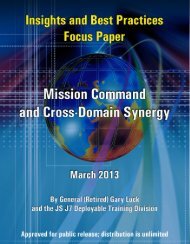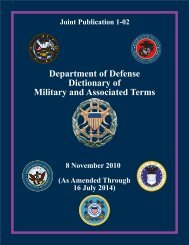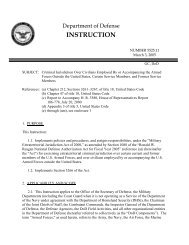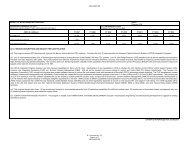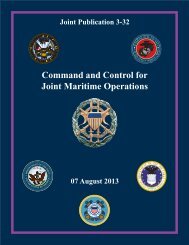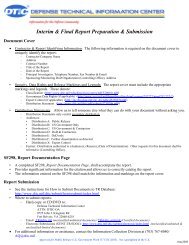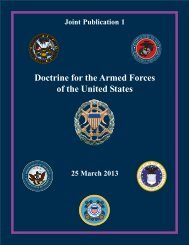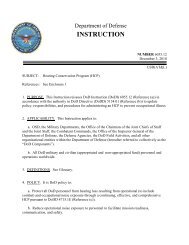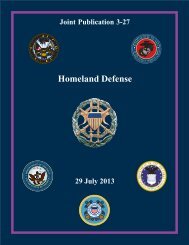JP 3-16, Multinational Operations - Defense Technical Information ...
JP 3-16, Multinational Operations - Defense Technical Information ...
JP 3-16, Multinational Operations - Defense Technical Information ...
You also want an ePaper? Increase the reach of your titles
YUMPU automatically turns print PDFs into web optimized ePapers that Google loves.
Chapter III<br />
(3) <strong>Multinational</strong> operations are becoming the norm for military operations, making<br />
intelligence and information sharing with partner nations increasingly important.<br />
Cyberspace connectivity, security, and assurance are essential for the multinational and HN<br />
forces’ effective mutual support during operations. Cyberspace interoperability issues<br />
should also be considered in light of the information assurance requirement.<br />
(4) Cyberspace efforts by all adversaries may include attempts to penetrate US,<br />
MNF, and HN networks to collect data on forces and systems, or to create denial or<br />
manipulation effects. Close coordination and partnership between forces, public-private<br />
stakeholders, and multinational partners will be required to rapidly develop and maintain<br />
cyberspace SA.<br />
15. Stability <strong>Operations</strong><br />
a. Stability operations are a core US military mission that helps to establish order that<br />
advances US interests and values. The immediate goal often is to provide the local populace<br />
with security, restore essential services, and meet humanitarian needs. The long-term goal is<br />
to help develop indigenous capacity for securing essential services, a viable market<br />
economy, rule of law, democratic institutions, and a robust civil society.<br />
b. Stability operations are necessary to ensure that the threat (military and/or political)<br />
is reduced to a manageable level that can be controlled by the potential civil authority or, in<br />
noncombat situations, to ensure that the situation leading to the original crisis does not<br />
reoccur or that its effects are mitigated.<br />
c. Stability operations that support transition and reconstruction efforts primarily<br />
support USG departments and agencies, IGOs, and NGOs to restore civil authority, rebuild<br />
the infrastructure, and reestablish commerce, education, and public utilities.<br />
d. Joint force planning and operations conducted prior to commencement of hostilities<br />
should establish a sound foundation for operations in the stabilize and enable civil authority<br />
phases. JFCs should anticipate and address how to fill the power vacuum created when<br />
sustained combat operations wind down. Accomplishing this task should ease the transition<br />
to operations in the stabilize phase and shorten the path to the national strategic end state and<br />
handover to another authority. Considerations include:<br />
(1) Limiting the damage to key infrastructure and services.<br />
(2) Establishing the intended disposition of captured leadership and demobilized<br />
military and paramilitary forces.<br />
(3) Providing for the availability of cash.<br />
(4) Identifying and managing potential stabilize phase enemies.<br />
(5) Determining the proper force mix (e.g., combat, military police, CA, engineer,<br />
medical, multinational).<br />
III-32 <strong>JP</strong> 3-<strong>16</strong>



